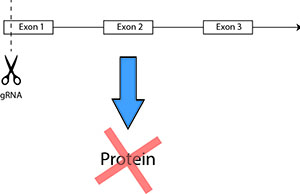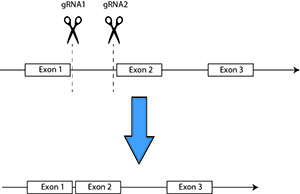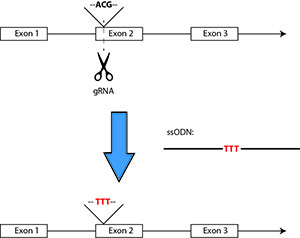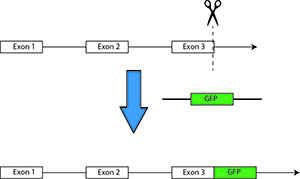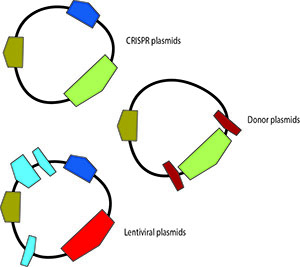If you would like to request this service, please fill out and send us the requisition form. Reach out if you have questions, need a time estimate or want guidance to figure out what fits your researchs' needs.
Generating mutant mice with CRISPR/Cas9
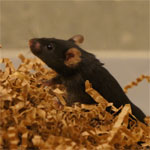
CRISPR/Cas9 technology is a novel technique to quickly and inexpensively generate mice with targeted mutations. Its core is an artificial nuclease that cuts the genome only in the target region.
DNA repair then induces a deletion around the cut site resulting in a knockout. Conditional knockouts and knockins of point mutations or reporter genes can be generated by adding the DNA to be introduced flanked by short homologous regions.
The TCF can design and prepare for you all DNA constructs required for your project, perform the ES cell manipulation, if CRISPR genome editing is not carried out in vivo, and genotype ES cells and mice. Alternatively, you can do the molecular biology work yourself and the TCF will carry out ES cell handling and embryo injections.
Examples of CRISPR genome edition applications
Gene knockout
To knockout a protein coding gene, a CRISPR/Cas9 nuclease is designed that cuts in the beginning of the coding region of the gene of interest. This will result in frameshift mutations leading to a functional gene deletion. This knockout will directly be carried out in fertilized oocytes resulting in heterozygous or homozygous knockout mice, though sometimes mosaic.
Specific genomic deletion
Using two CRISPR/Cas9 endonucleases, one can delete the intervening genomic DNA sequence. This method can be applied to delete protein coding genes or specific splice variants, but also to eliminate non-coding DNA such as enhancer elements, intronic sequences, and non-coding RNA. This deletion will directly be carried out in fertilized oocytes resulting in heterozygous or homozygous mutant mice, though sometimes mosaic.
Point mutations
Often, small changes in the DNA sequence are contributing to specific diseases. By introducing these mutations to mice, an accurate disease model can be generated with high relevance for patients carrying this mutation. Small mutations (~1 to 10 nucleotides) such as gene point mutations can be introduced by a CRISPR/Cas9 endonuclease cutting close to the site to be mutated together with a single-stranded donor DNA oligonucleotide (ssODN), which will harness the cell machinery for homologous recombination in order to insert the mutation of interest.
Gene knock in
To introduce larger pieces of DNA, such as reporter genes, or to replace mouse genes by human genes (“humanized mice”), double stranded DNA constructs will be used, where the DNA to be inserted is flanked by 0.3 to 0.8 kb homology arms, which are identical to the genomic region where the exogenous DNA should be introduced.
Plasmid Design and Cloning
If in vitro research is your focus, we also offer services in the cloning of CRISPR-related constructs that you can easily use to generate your own genetically modified cell lines.
More information about the method
1. First description of the use of CRISPR/Cas9 for making genetically modified mice
One-step generation of mice carrying mutations in multiple genes by CRISPR/Cas-mediated genome engineering.
Wang H, Yang H, Shivalila CS, Dawlaty MM, Cheng AW, Zhang F, Jaenisch R. Cell. 2013 May 9;153(4):910-8
2. Complete description of how to make CRIPSR/Cas9 targeted mice
Generating genetically modified mice using CRISPR/Cas-mediated genome engineering.
Yang H, Wang H, Jaenisch R. Nat Protoc. 2014 Aug;9(8):1956-68.

